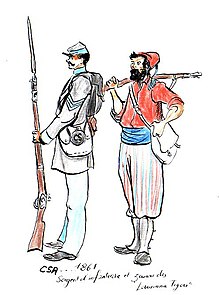9th Louisiana Infantry Regiment (Confederate)
Originally applied to a specific company, the nickname expanded to a battalion, then to a brigade, and eventually to all Louisiana troops within the Army of Northern Virginia.
Although the exact composition of the Louisiana Tigers changed as the war progressed, they developed a reputation as fearless, hard-fighting shock troops.
The origin of the term came from the "Tiger Rifles," a volunteer company raised in the New Orleans area as part of Major Chatham Roberdeau Wheat's 1st Special battalion, Louisiana infantry.
During the 1863 Gettysburg Campaign, Hays' Brigade played a crucial role in the Confederate victory at the Second Battle of Winchester, seizing a key fort and forcing the withdrawal of Union troops under Maj. Gen. Robert H. Milroy.
[1] At the Battle of Gettysburg, Hays' Brigade stormed East Cemetery Hill on the second day and seized several Union artillery pieces before withdrawing when supporting units were not advanced.
In the autumn of 1863, more than half the brigade was captured at the Battle of Rappahannock Station, and 1,600 men were shipped to Northern prisoner-of-war camps, many to Fort Delaware.
Following the Civil War, many former Tigers joined the Hays Brigade Relief Association, a prominent New Orleans social and political organization.
A company of former Louisiana Tigers joined the Fenian Invasion of Upper Canada on June 1, 1866, and fought the Canadian militia the next day at the Battle of Ridgeway.
